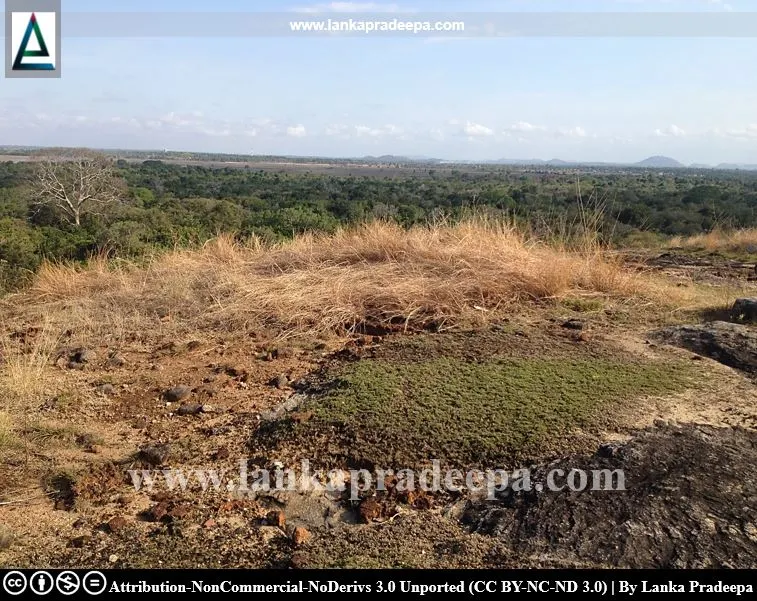
Buddhangala Aranya Senasanaya, also known as Buddhangala Raja Maha Viharaya, Buddhangala Thapovanaya (Sinhala: බුද්ධංගල විහාරය, බුද්ධංගල තපෝවනය) is a forest hermitage located in the Buddhangala Sanctuary in Ampara District, Sri Lanka. The site can be reached by travelling along the Buddhangala - Ruhunugama road about 7.5 km distance from Ampara town.
History
As the presence of less decorated Sandakada Pahana (moonstone), Korawak Gal (wingstones), Muragal (guard stones), and stone pillars, the history of Buddhangala can be dated to the early part of the Anuradhapura Period (Wijesingha, 1998). Three cave inscriptions found on the temple premises undoubtedly indicate the existence of an early Buddhist monastery at the site (Wijesingha, 1998). From these inscriptions, two were copied and published by professor Senarat Paranavitana in his book "Inscription of Ceylon; Vol 1" (Paranavitana, 1970).

Buddhangala Cave Inscriptions
Period: 2nd - 1st centuries B.C.
Scripts: Early Brahmi
Language: Old Sinhala
Transcript: Karajhikagala vahike bata Digathiha lene niyate shagasha
Translation: The cave of lord Digati, the resident of Karajhigala is donated to the Sangha
Reference: The information board at the site by the Department of Archaeology and the State Ministry of Cultural Affairs.
The second cave inscription also records a donation (the cave) made to the Sangha (Buddhist monks) of four quarters (who were present and absent) by the chief Sujata, son of chief Uti, the revenue collector of Cittadevi (Paranavitana, 1970). Here the person named Citta-Devi, according to some could be the same one (or has a relation) who is mentioned in the cave inscription discovered from Uttara Jayamaha Viharaya in nearby Hingurana town, in which that name is mentioned as Racita or Cita (Dias, 1991; Medhananda, 1984; Suseema Thera, 2015).
The third inscription mentions a person named Dirgamitta, the son of Shiva (Medhananda, 1984).
Rediscovery of the site
The Buddhangala temple which was in a state of ruins for a long period was re-discovered in 1964, by a Buddhist monk named Kalutara Dhammananda Thera (Wijesingha, 1998).
Archaeological Ruins
The temple complex is situated on a rock outcrop extending over a large area. Several rock caves with drip ledges are found in the western part of the rock. A retaining wall made of rubble and plain Muragal and Korawak Gal can be seen on the eastern slope (Withanachchi, 2013). The main rock plateau where an ancient Vatadageya was located is abundant with several archaeological ruins. Sandakada Pahana, Korawak Gal, Mura Gal, stone pillars, Nidan Gal (treasure stones), and a large collection of other artefacts such as fragments of clay bowls, bricks, potteries, turrets, and bronzes have been unearthed from the informal excavations carried out during the early 1970s (Wijesingha, 1998). A golden casket containing relics was discovered on 29 September 1972, from the excavations done in the ancient Vatadageya site (Suseema Thera, 2015; Wijesingha, 1998).
The golden relic casket
Three miniature lotuses carrying small bowls of corporeal relics are said to be preserved in this relic casket (Medhananda, 2003; Suseema Thera, 2015). The bowls were covered with caps and two of them had Bo-leaves inscribed with Brahmi letters (Wijesingha, 1998). These writings have been read as "Shariputhasa Mahamugalana", the names of the two main Arhats of the Buddha, Seriyuth (Shariputta) and Mugalan [(Moggallana) Medhananda, 2003; Suseema Thera, 2015; Wijesingha, 1998]. The third lotus was said to be fixed at a higher position than the other two and therefore it has been assumed that the third bowl contains the relics of Buddha (Suseema Thera, 2015; Wijesingha, 1998). Today, these relics have been deposited in a special chamber of the Stupa and are exhibited for the public on Poson Full Moon Poya Day in June every year.
Buddhangala Sanctuary
The forest surrounding the Buddhangala monastery was declared as one of the Sanctuaries in Sri Lanka by a government Gazette notification published on 01 November 1974.






References
1) Dias, M., 1991. Epigraphical notes (Nos 1 -18). Colombo: Department of Archaeology. p. 4.
2) Medhananda, E. 1984. Aprakata Brahmi Sellipi Ha Puravastu (In Sinhala). Sri Lanka Society of Archaeology. pp.22-23.
3) Medhananda, E., 2003. Pacheena passa - Uttara passa: Negenahira palata ha uturu palate Sinhala bauddha urumaya (In Sinhala). Dayawansa Jayakody & Company. Colombo. ISBN: 978-955-686-112-9. pp.209-211.
4) Paranavitana, S., 1970. Inscription of Ceylon: Volume I: Early Brahmi inscriptions. Department of Archaeology Ceylon. p.36.
5) Suseema Thera, D., 2015. Agasawda weda hindina pujaneeya Buddhangala wana senasuna (In Sinhala). Published by the editor. ISBN: 978-955-986-09-1-4. pp.41,43,54.
6) The Gazette of the government. No: 134. 01 November 1974. p. 907.
7) Wijesingha, D., 1998. (Editor: Nahiya, A.M.). Aithihasika Buddhangala Thapovanaya
(In Sinhala). North-East Sri Lanka; A compendium; 50th Anniversary of
Sri Lanka's Independence 1948-1998. North-East Provincial Council,
Trincomalee. pp.75-77.
8) Withanachchi, C. R., 2013. Pauranika Sthana Saha Smaraka: Ampara
Distrikkaya (In Sinhala). Department of Archaeology (Sri Lanka). ISBN:
955-9159-44-5. pp.37-38.

